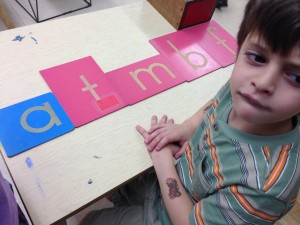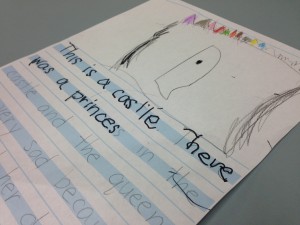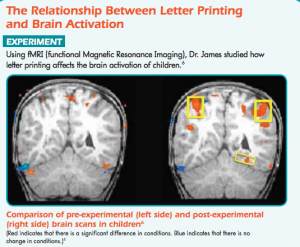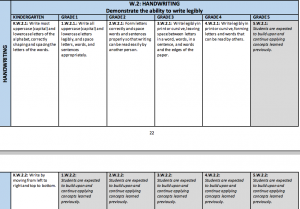Indiana’s New Handwriting Standards More Detailed Than Common Core

Claire McInerny / StateImpact Indiana
A 4-year-old in Eve Cusack's class at Bloomington Montessori School practices his letter sounds by tracing over the sandpaper letter blocks.
The ability to write by hand is a skill we use our entire lives. Making a grocery list, writing a reminder on a Post-It or adding a tip to a restaurant receipt all require the fine motor skills and the understanding of language involved in writing.
Learning these skills start early, and as researchers are finding out, learning them helps a child develop cognitively if started early on.
When Indiana ditched the Common Core in April and wrote its own academic measures, authors of the new standards created detailed handwriting standards. Compared to the previously used Common Core standards, Indiana’s standards provide specific skills a child should meet every year of elementary school.
[audio href=”https://indianapublicmedia.org/stateimpact/files/2014/06/FEAHandwriting_mixdown.mp3″ title=”The Cognitive Effects Of Handwriting For Children”] Indiana’s new academic standards include a detailed section regarding handwriting, after hundreds of public comments requested it. As StateImpact Indiana’s Claire McInerny reports, focusing on handwriting not only helps a child academically, but also cognitively. [/audio]John Wolf, Elementary Literacy Specialist for the Department of Education, says during the public comment period of writing the new standards, the IDOE received more than 600 comments regarding handwriting and cursive.
“What we ended up hearing more and more from a lot of the responses was that they wanted their child to be able to read historical documents or diaries or letters,” Wolf said. “They were really concerned that many children couldn’t read cursive so that was one of the areas that we wanted to go back and look at.”
Developing The ‘Pincer Grasp’
Before a child can begin meeting the first of the handwriting standards, they have to have the motor skills to write and hold a pencil–skills preschool teacher Eve Cusack focuses on with her 3- to 6-year-olds at Bloomington Montessori School.
“One thing that is widely agreed upon, is that children can’t really control their fine motor skills until they’ve got good gross motor control,” Cusack said. “We have a blue line that you see on the floor it’s in the shape of an ellipse and walking on the line is an indoor gross motor skill children can do.”

Claire McInerny / StateImpact Indiana
An example of story picture writing in Cusack's classroom, one of the more advanced handwriting activities.
She encourages fine motor skills development by having children use eyedroppers, tongs and other tools that force a child to use the “pincher grasp” similar to holding a pencil.
Once a child is ready to start writing, Cusack takes them through a progression of practicing letter sounds and tracing letters with their finger and work up to story picture writing, where the child draws a picture and verbally explains what’s happening in the story so Cusack can write it down. The child later writes over her works with a marker.
Even though handwriting is a major focus once a child reaches elementary school, Cusack says its crucial to a child’s success to begin when they are three and four.
“For most children, their sensitive period for letter sounds is around age four or four and a half,” Cusack said. “And at those few weeks they can learn them all very quickly.”
How Writing Looks On A Brain Scan
Not only does writing in preschool help a child once they get to kindergarten, but Indiana University neuroscience Karin Harmen James says it has an affect on their brain function.
During her research studies, she divides 4- to 6-year-old children into three groups: one where they learn letters by sight, one where they type letters on a keyboard, and one where they write it by hand. Then the children go into a functional MRI and are shown letters, and for only one of the groups of children, the brain begins to light up when they see the letters.

https://www.hw21summit.com/media/zb/hw21/files/H2948_HW_Summit_White_Paper_eVersion.pdf
A copy of brain scans from James research, printed in 'A Summary of Research Presented at Handwriting in the 21st Century? An Educational Summit'.
“The network that we use as literate individuals to read, doesn’t become active unless children print the letters,” James said.
So does that mean having kids write letters helps them read later on?
“That link hasn’t been established in terms of our research but other groups have done letter recognition, which is a really important precursor to reading acquisition, and they found that the printing does facilitate letter recognition, so it makes those children recognizes letters easier once they print them,” she said.
James saw no difference in brain stimulation when children wrote in cursive or print letters, just the act of writing activated the system.


